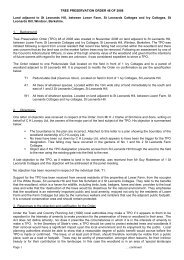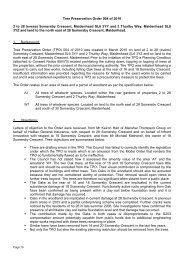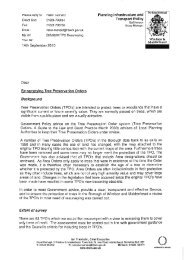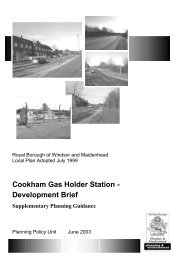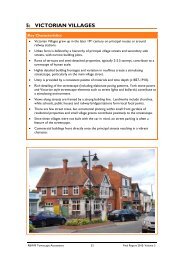Maidenhead Riverside Conservation Area Appraisal - The Royal ...
Maidenhead Riverside Conservation Area Appraisal - The Royal ...
Maidenhead Riverside Conservation Area Appraisal - The Royal ...
- No tags were found...
You also want an ePaper? Increase the reach of your titles
YUMPU automatically turns print PDFs into web optimized ePapers that Google loves.
22<br />
<strong>Maidenhead</strong> <strong>Riverside</strong> <strong>Conservation</strong> <strong>Area</strong> <strong>Appraisal</strong><br />
5<br />
Location, Setting and Development of the <strong>Area</strong><br />
5.23 <strong>The</strong> riverside area drew the interest of Victorian high society due to the proximity of Taplow Court and<br />
Cliveden. <strong>The</strong> two big houses entertained the world famous including royalty and international ambassadors,<br />
giving <strong>Maidenhead</strong> riverside a cosmopolitan air. <strong>The</strong> steady stream of visitors who stayed with the Grenfells at<br />
Taplow Court and the Astors at Cliveden included King Edward VII, Lord Kitchener and Oscar Wilde. William<br />
Henry Grenfell, elevated to Lord Desborough, was a champion of the Thames and its uses. He was both Captain<br />
and coach at <strong>Maidenhead</strong> Rowing Club, located next to the Thames Riviera Hotel. This interest was originally<br />
focused on the inn known as Orkney Arms on the Taplow side of the Thames, which was subsequently bought<br />
by William Skindle and became known as Skindles Hotel. This hotel is considered responsible for the origins<br />
of <strong>Maidenhead</strong> as a fashionable, elite resort.<br />
5.24 Many hotels and clubs soon followed suit and sprung up along the riverfront. Boulters Lock was at the<br />
centre of the merriment and was at this time the most famous and busiest lock on the Thames. <strong>The</strong> lock was<br />
replaced in 1829 and again in 1912 (opened by Lord Desborough). <strong>The</strong> most famous lock keeper was Turner<br />
who served from 1880-1904. In 1909 the Thames Conservancy bought the Ray Mill Island and demolished the<br />
mill, but retained the Mill House which became Boulters Lock Hotel.<br />
5.25 <strong>The</strong> Ascot Sunday parade was the culmination of the social season. Thousands crowded the river bank<br />
to watch the cream of high society at play. In 1888 on Ascot Sunday as many as 800 boats passed through<br />
Boulters Lock, whilst on the same day in 1904 this figure had risen to 1000 small craft and 182 launches.<br />
5.26 <strong>Maidenhead</strong> became known as ‘Mayfair on the Thames’ a playground for the rich and famous during<br />
the ‘naughty nineties’ (1890-1914). <strong>The</strong> best known of the <strong>Maidenhead</strong> clubs was that of the Brigade of the<br />
Guards. In 1903 Lord Cheylesmore donated two Edwardian houses, <strong>Riverside</strong> and Edendale and an island in<br />
the Thames for the purposes of creating their new premises. Outside there was a swimming pool, croquet lawn<br />
and on the island a boathouse. <strong>The</strong>ir annual Ascot Ball was famous and frequently attended by royalty.<br />
5.27 Jerome K Jerome (1899, Three Men in a Boat) ‘<strong>Maidenhead</strong> is too snobby to be pleasant. It is the haunt<br />
of the river swell and his overdressed river companion. It is the town of showy hotels, patronised chiefly by<br />
dudes and ballet girls’.<br />
5.28 <strong>The</strong> Ray Mead Hotel is illustrated on the 1875 OS map and by 1890 was extended and boasting full<br />
electricity throughout, however by 1910, had gone bankrupt. <strong>The</strong> Thames Hotel was built by H Woodhouse by<br />
1883. <strong>The</strong> Thames Riviera Hotel was originally conceived as mansion to let but later opened as a hotel in 1888.<br />
Many of the riverside clubs were held in back rooms and cellars of private houses which had sprung up along<br />
the riverside. <strong>The</strong> wharf which had existed from the 12th to the 18th century by <strong>Maidenhead</strong> Bridge was replaced<br />
by Bridge House in the 19th century, which was converted to Murrays River Club in 1911.<br />
5.29 <strong>The</strong> late Victorian era had a huge influence on the riverside of <strong>Maidenhead</strong> and shifted the focus of the<br />
area from commercial activities towards recreational pursuits, the legacy of which remains today. <strong>The</strong> population<br />
of <strong>Maidenhead</strong> during the last two hundred years illustrates the importance of the railway and the subsequent<br />
Victorian boom. In 1801, the population of <strong>Maidenhead</strong> was at 949 and had altered little from medieval times<br />
with fewer than 200 homes. By 1851, following the advent of the railway, the population had more than tripled<br />
to 3,603. By the end of the Victorian era in 1901, this figure had reached 12,980.<br />
5.30 <strong>The</strong> riverside frivolities were brought to an abrupt halt in 1914. After the war, the festivities were renewed,<br />
although never to the same scale. However, until WWII, Ascot Sunday was still considered the social event of<br />
the year. In 1932 over 12,000 vehicles were recorded travelling over the <strong>Maidenhead</strong> Bridge bringing people<br />
to watch the spectacle. By the 1940’s, the riverside society had all but diminished. <strong>The</strong> boatyards largely closed<br />
down, the punting regatta moved away and the pleasure steamers were replaced by diesel. Much of the riverside<br />
area was redeveloped for mass housing following the end of the war. Murrays River Club was closed and<br />
demolished by the 1940's, becoming Bridge Gardens. <strong>The</strong> Guards Club was closed and largely demolished in<br />
the 1960’s. <strong>The</strong> connected island and much of the land was then landscaped to form Guards Club public park.<br />
Archaeology<br />
5.31 <strong>The</strong> name <strong>Maidenhead</strong> first came into use in the 13th century to describe the small settlement previously<br />
known as Ellitone. <strong>The</strong> settlement was closely allied to the River Thames crossing, with the timber bridge, first<br />
documented in 1280, forming the main crossing point of the Thames for east-west traffic.








